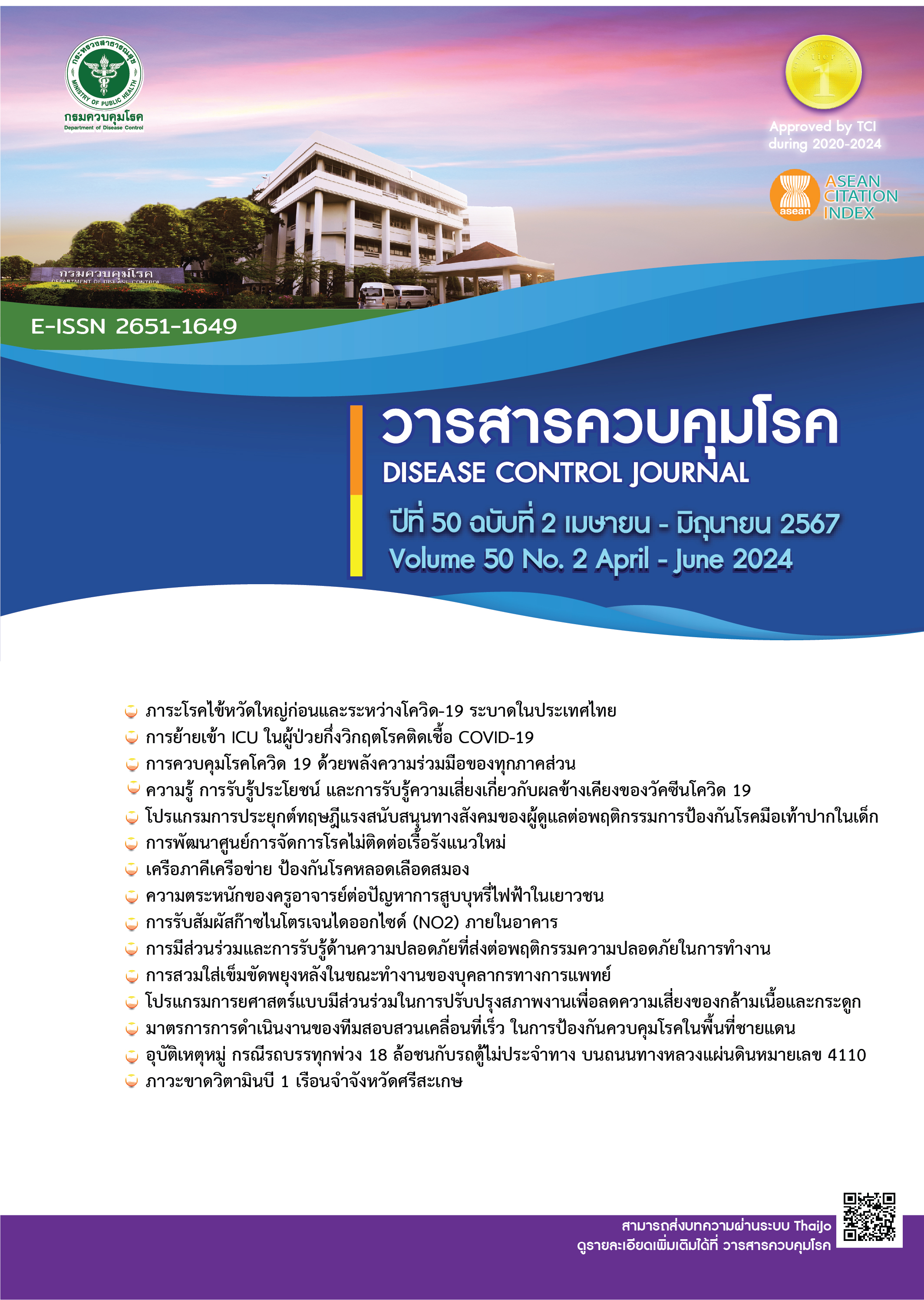Development of community health network to prevent cerebrovascular disease in the high-risk group, Pak Thong Chai District, Nakhon Ratchasima Province
DOI:
https://doi.org/10.14456/dcj.2024.22Keywords:
health network development, health network development, cerebrovascular disease, risk groupAbstract
The prevention of cerebrovascular disease in a high-risk group in Pak Thong Chai District, Nakhon Ratchasima Province had been operated without cooperation of health network. Consequently, we addressed the weakness through a “participatory action research.” The samples consisted of 20 individuals from the community health network known as “Pak Thong Chai Model” and 257 high-risk subjects (i.e. patients diagnosed with diabetes, hypertension, and hyperlipidemia, and were receiving treatment at Pak Thong Chai Hospital). The study implementation was divided into three phases: preliminary data study, development process, and the outcomes from health network collaboration. The data were collected using questionnaires and recording forms. Data analysis was performed using descriptive statistics (frequency, percentage, mean, and standard deviation), analytical statistics (paired t-test), and content analysis. The results showed: 1) The health network including doctors, nurses, public health officers, village health volunteers (VHVs), and academicians were responsible for 1.1) Organizing health care activities based on the principle of “Eight Healthy Habits”, 1.2) Evaluating results, 1.3) Implementing lessons learned, and 1.4) Adjusting drug use; 2) the program implementation outcomes included: 2.1) Capacity building program for health network, 2.2) Working systems and mechanisms for the health network, 2.3) Guidelines for rational drug use, and 2.4) Increased scores for knowledge and skills of the health network after the program development and implementation (p<0.05); 3) The outcomes from health network collaboration indicated that the high-risk group exhibited a higher behavioral level than before the program development and implementation (p<0.05). Moreover, patients with prolonged illness lasting three to over 10 years were successful in controlling the diseases. There were 60.14%, 64.14%, and 98.11% of the subjects who were able to reduce or stop using medications for the treatment of diabetes, hypertension, and hyperlipidemia, respectively. More importantly, new findings and outcomes were discovered: 1) Patients were the first doctor to care for themselves, 2) There was a novel health station that has made the local communities more self-reliant when it comes to health care, 3) Criteria for dose reduction and permanent discontinuation of medications which includes: 3.1) Unusual symptoms occurring after regular administration of medication, low blood sugar or blood pressure or lipid profile, 3.2) Weekly measurement and recording of blood sugar level and/or blood pressure, and 3.3) The risk group had to regularly practice the Eight Healthy Habits. Suggestion: For those at risk, incorporating lifestyle changes alongside adjusting or discontinuing medication, according to guidelines, is key to preventing cerebrovascular disease.
Downloads
References
World Health Organization. Stroke, Cerebrovascular Accident [Internet]. 2023 [cited 2023 Sep 10]. Available from: https://www.emro.who.int/health-topics/stroke-cerebrovascular-accident/index.html
Norseeda W, Chomnirat W. Development Stroke Prevention Guideline for Uncontrolled Hypertension Patients in SAM Phrao Health Promoting Hospital. Journal of Nursing and Health Care 2019;34(4):167-76. (in Thai)
Tiamkao S. Stroke Situation in Thailand. Thai Journal of Neurology 2022;39(2):54-60. (in Thai)
Channuan S, Panomai N. Perception and Self-Care Behavior to Prevent Stroke in Diabetic Patients at Khonsawan Hospital, Chaiyaphum Province. Journal of Sakon Nakhon Hospital 2018;21(2):120-8. (in Thai)
Maneechom S. Factors Influencing the Ability for Self-Care and the Quality of Life of Stroke Patients at Chiang Mai Neurological Hospital [Internet]. 2022 [cited 2023 Jun 25]. Available from: https://www.cmneuro.go.th/TH/research /63-Full%20Paper-สุทิน%20มณีชมภู.pdf (in Thai)
Department of Disease Control (TH), Division of Non-Communicable Diseases. Prevention of non-Communicable Diseases [Internet]. 2023 [cited 2023 Jul 9]. Available from: http://www.thaincd.com/
Ministry of Public Health (TH), Drug and medical supply information center. Guidelines for Organization of Digital Health Station Services [Internet]. 2022 [cited 2023 Oct 24]. Available from: https://dmsic.moph.go.th/index/detail/ 9099. (in Thai)
Kemmis S, McTaggart R, Nixon R. The Action Research Planner. 3rd ed. Geelong: Deakin University; 1992.
Nakhon Ratchasima Rajabhat University, Faculty of Public Health. 8 Parallel Drug Training Courses for NCDs Killing (Enhance the
Management of Chronic Non-Communicable Diseases with 4 Elements Principle). Nakhon Ratchasima Province: Nakhon Ratchasima
Rajabhat University; 2019. (in Thai)
Pakthongchai Hospital. Chronic Non-Communicable Diseases Report 2021. Pakthongchai Hospital Pak Thong Chai District, Nakhon Ratchasima Province; 2022. (in Thai)
Inthakanok S, Satayavongthip B, Singsalasang A, Nguanjairak R, Seesan C, Salawongluk T. Development of Village Health Volunteer’s Capacity on Chronic Non-Communicable Diseases Management: A study of the Responsible Area of Nam Sub Health Promoting Hospital, Pak Thong Chai District, Nakhon Ratchasima Province. The Office of Disease Prevention and Control 9th
Nakhon Ratchasima Journal 2021;27(1):56-67. (in Thai)
Bloom BS, Hastings JT, Madaus GF. Handbook on formative and summative evaluation of student learning. New York: McGraw-Hill; 1971.
Best JW. Research in Education. 3rd ed. New Jersey: Prentice Hall; 1981.
Kanfer FH, Goldstein AP. Helping People Change: A textbook of Methods. 3rd ed. New York: Pergamon Press; 1991.
Prentice-Dunn S, Rogers RW. Protection Motivation Theory and Preventive Health: Beyond the Health Belief Model. Health Education Research 1986;1(3):153-61.
Glaharn L, Salawongluk T, Satayavongthip B. The Development of Caregivers, Skills for Improving Long Term Care Service to Relieve Family Caregivers Burdens. Health Education Journal 2023;46(1):26-37. (in Thai)
Phurichaivoranant C. Factors Related to Public Health Administration of District Public Health Officers in Kanchanaburi Province. Community Public Health Journal 2019;5(4):11-15. (in Thai)
Fishbien M, Ajzen Z. Belief, attitudes intention and behavior: an introduction theory and research. Massachusetts: Addison Wesley; 1973.
Hirungerd S, Saenloa P, Thongsawang K. Development of a Care System for Stroke Patients with Community Participation in Bansog Subdistrict, Khonsawan District, Chaiyaphum Province. Journal of Nursing 2021;70(4):34-43. (in Thai)
Bandura A. Self-Efficacy: The Exercise of Control. New York: W.H. Freeman and Company; 1997.
Sutthinarakorn W. Participatory Action Research and Conscientization. Bangkok: Siamparitut; 2014. (in Thai)
Downloads
Published
How to Cite
Issue
Section
License
Copyright (c) 2024 Disease Control Journal

This work is licensed under a Creative Commons Attribution-NonCommercial-NoDerivatives 4.0 International License.
Articles published in the Disease Control Journal are considered as academic work, research or analysis of the personal opinion of the authors, not the opinion of the Thailand Department of Disease Control or editorial team. The authors must be responsible for their articles.






